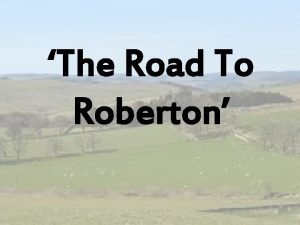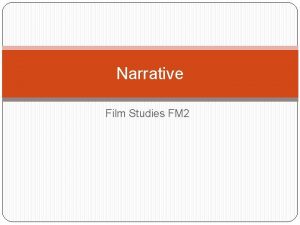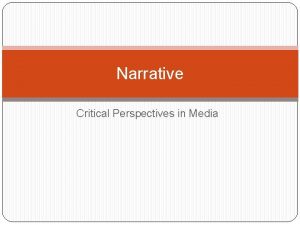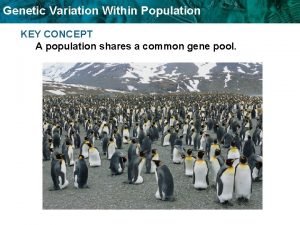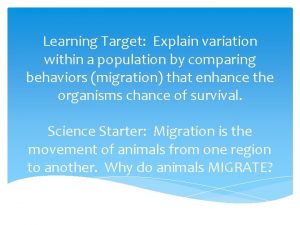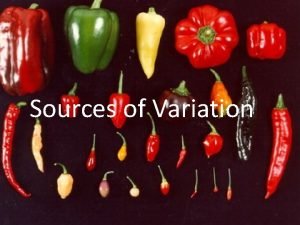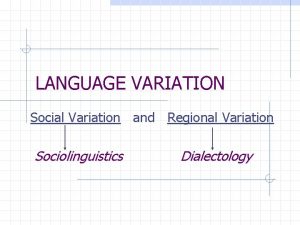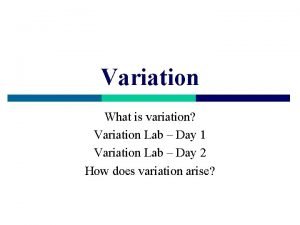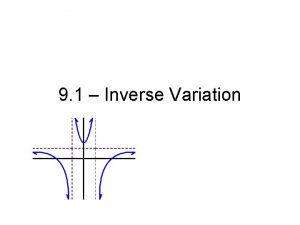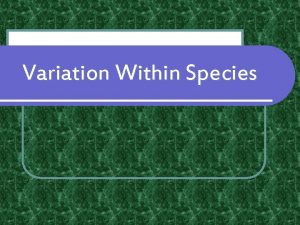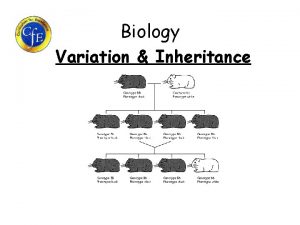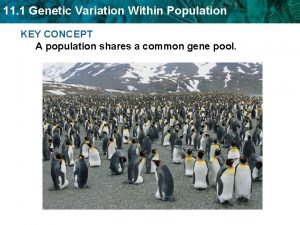Variation Learning Intentions Variation within a population makes































- Slides: 31

Variation Learning Intentions: • Variation within a population makes it possible for a population to evolve over time in response to changing environmental conditions. • State that an adaptation is an inherited characteristic that makes an organism well suited to survival in its environment. • State that variation can occur within a population caused by meiosis, sexual reproduction and mutation. • Give examples of variation within a population. • State that variation leads to evolution over time in response to changing environmental conditions.

Starter… On a show me board list all the differences between animals naturally found in Scotland animals found near the equator.

Variation Learning Intentions: • State that variation can occur within a population caused by meiosis, sexual reproduction and mutation. • State that variation leads to evolution over time in response to changing environmental conditions. Success Criteria: • Describe the differences in populations • Investigate variation in humans and plants

Variation is the differences found throughout a species. It is caused by mutations, meiosis and sexual reproduction. Mutations cause differences in individuals. If these mutations are advantageous or neutral to the organism, it will survive and reproduce, passing its genes (and the difference) onto the next generation. Variation leads to evolution over time in response to changing environmental conditions.

Numeracy Unit 2 recap Variation in Humans 1. Carry out a survey of tongue rolling, eye colour and foot length in your class. 2. Discuss what kind of table you could use to record your results. 3. Draw 3 suitables to record your result. 4. Collect data from your class. 5. Select one characteristic and draw a suitable graph. 6. Identify the characteristic as continuous or discrete variation. 7. Describe what your results and graph show. 8. Describe how your survey could be improved.

Numeracy Unit 2 recap Variation in plants 1. Complete a survey on plant height, petal colour and leaf number or shape. 2. Discuss what kind of table you could use to record your results. 3. Draw 3 suitables to record your result. 4. Collect data from your class. 5. Select one area and draw a suitable graph. 6. Identify the characteristic as continuous or discrete variation. 7. Describe what your results and graph show. 8. Describe how your survey could be improved.

Unit 2 recap Continuous Variation • A characteristic that gradually changes over a range of values. • E. g, height, weight, foot length.

Unit 2 recap Discrete Variation • A characteristic with only a limited number of possible values. • E. g. blood group, ear lobes (attached or unattached) or tongue rolling ability.

Variation Learning Intentions: • State that variation can occur within a population caused by meiosis, sexual reproduction and mutation. • State that variation leads to evolution over time in response to changing environmental conditions. Success Criteria: • Describe the differences in populations • Investigate variation in humans and plants

Starter: On a show me board write your ideas about these questions: 1. Why do sheep survive here in Scotland? 2. Why would you not find the same sheep living in South Africa?

Variation Learning Intentions: • Variation within a population makes it possible for a population to evolve over time in response to changing environmental conditions. • State that variation leads to evolution over time in response to changing environmental conditions. Success Criteria: • Explain what an adaptations is and why it helps organisms survive in the habitat in which they live

Different types of environment There are three major types of environment. What are they? land freshwater marine How do organisms survive in such different environments?

What does the word adaptation mean to you?

Adaptations • An adaptation is an inherited characteristic that makes an organism well suited to survival in its environment or niche – role within the environment. • If an organism can survive long enough to reproduce they are able to pass their DNA (with these characteristics) onto the next generation.

What adaptations have occurred in each of these pictures? Look at how quickly the chameleon in this clip can adapt! http: //www. chameleonshops. com/super-chameleon/


• An adaptation can be structural or behavioural. Both can aid the organism’s survival.

Structural Adaptation A desert is a habitat where the conditions are extremely dry and the soil lacks water. A normal land plant e. g. an oak tree would be unable to survive in the desert. A desert plant such as the cactus is able to survive in the desert because it possesses certain adaptations:

Structural adaptations • Stem is fleshy and stores water in succulent tissues. • Water loss from the stem is kept to a minimum by thick, waxy cuticle which coats its outer surfaces. • Leaves are reduced to spines to reduce water loss and protect the plant from herbivores.

Structural adaptations Roots: • Some cacti have very long roots for reaching supplies of subterranean water. • Others possess extensive systems of superficial roots which grow parallel to the soil surface. These enable the plant to absorb maximum quantities of water when it rains.

Cactus and adaptation clips • http: //www. bbc. co. uk/learningzone/clips /adaptation-of-plants-andanimals/5304. html • http: //www. bbc. co. uk/learningzone/clips /how-cacti-survive-withoutwater/66. html

Adaptations of a Desert Plant Your task… Using the information you have just learnt produce a summary diagram to show the structural adaptations of a desert plant. How am I adapted to live in the desert?

Plant Adaptations • Bee pollinated plants have adapted to have petal colours related to bee vision.

Bumblebee vision. • Bumblebees have two eyes and also detect light with 3 ocelli or “primative eyes”.

Bumblebee vision • Bumblebees cannot see the colour red but can see UV light that we cannot.

Plant adaptations • Plants have adapted to have petal colours which bumblebees can see and are attracted to. This means they are pollinated and pass their genes onto the next generation. But, bumblebees do sometimes visit red flowers… - can you think of a reason why?

• Red flowers visited by bumblebees may have emitted attractive smells or have UV patterns we cannot see.



Variation Learning Intentions: • Variation within a population makes it possible for a population to evolve over time in response to changing environmental conditions. • State that variation leads to evolution over time in response to changing environmental conditions. Success Criteria: • Explain what an adaptations is and why it helps organisms survive in the habitat in which they live

 Poetry learning intentions
Poetry learning intentions Learning intention example
Learning intention example Learning intentions and success criteria examples
Learning intentions and success criteria examples Learning intentions and success criteria examples
Learning intentions and success criteria examples Nat 5 persuasive essay
Nat 5 persuasive essay Stage 2 whole number
Stage 2 whole number Poetry learning intentions
Poetry learning intentions Fractions objectives
Fractions objectives What is half turn symmetry
What is half turn symmetry Learning intentions verbs
Learning intentions verbs Poetry learning intentions
Poetry learning intentions Learning intentions and success criteria for mathematics
Learning intentions and success criteria for mathematics Poetry learning intentions
Poetry learning intentions Gap year poem
Gap year poem Creative writing learning intentions
Creative writing learning intentions Poem features
Poem features Drama learning intentions
Drama learning intentions The meaning of advent worksheet
The meaning of advent worksheet Shared clarity about learning intentions
Shared clarity about learning intentions Narrative learning intentions
Narrative learning intentions Act 2
Act 2 What is assessment
What is assessment 90 of the canadian population lives within
90 of the canadian population lives within What is direct variation
What is direct variation Inverse eq
Inverse eq Coefficient of determination formula in regression
Coefficient of determination formula in regression Section 1 population dynamics answer key
Section 1 population dynamics answer key Section 1 population dynamics answer key
Section 1 population dynamics answer key Population ecology section 1 population dynamics
Population ecology section 1 population dynamics Study guide section 1 population dynamics
Study guide section 1 population dynamics Cuadro comparativo de e-learning b-learning y m-learning
Cuadro comparativo de e-learning b-learning y m-learning Creative intentions meaning
Creative intentions meaning










